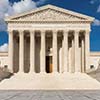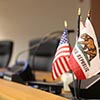Teacher Has Constitutional Right To Display Banners Containing Religious References In The Classroom

April 2010
Number 11
CLIENT NEWS BRIEF
TEACHER HAS CONSTITUTIONAL RIGHT TO DISPLAY BANNERS
CONTAINING RELIGIOUS REFERENCES IN THE CLASSROOM
In Johnson v. Poway Unified School District (Feb. 25, 2010) __F.Supp.2d__, a United States District
Court for the Southern District of California ruled that the Poway Unified School District ("District")
violated a high school teacher's free speech rights when it ordered him to remove two banners
from the walls of his classroom because they "over-emphasized" God.
For approximately two decades, Bradley Johnson, a math teacher in the District, had displayed
two banners in his classroom, one with the phrases "In God We Trust," "One Nation Under God,"
"God Bless America," and the other with the phrase "All Men Are Created Equal, They Are
Endowed By Their CREATOR." Over the years that Mr. Johnson taught in the District, he received
no complaints about the banners.
In January 2007, Mr. Johnson's principal ordered him to remove his banners after an inquiry from
a fellow teacher and a decision by the school board to direct their removal. The principal told
Mr. Johnson that the banners were impermissible because they conveyed a Judeo-Christian
viewpoint. Mr. Johnson sued the District, asserting federal and state constitutional claims.
The court held that the District violated Mr. Johnson's rights under the First and Fourteenth
Amendments of the United States Constitution and Article I, sections 2 and 3 of the California
Constitution. As a result, the court ordered the District to allow Mr. Johnson to return the two
banners to his classroom and awarded him nominal damages, along with reasonable
attorney's fees.
The court found that the District impermissibly restricted Mr. Johnson's speech based on
viewpoint, rather than for a content-neutral reason. The U.S. Supreme Court has made clear that
viewpoint discrimination occurs when the government "denies access to a speaker solely to
suppress the point of view he espouses on an otherwise includible subject." (Cornelius v. NAACP
Legal Defense and Education Fund Inc. (1985) 473 U.S. 788, 806.) As a result, the court found that
Mr. Johnson's speech was improperly suppressed because of its message.
The court noted that school teachers and students enjoy First Amendment rights inside the
"schoolhouse gate." (Tinker v. Des Moines Independent Community School District (1969) 393 U.S.
503 at 396.) The court determined that Mr. Johnson's classroom walls constituted a "limited
public forum" because the District had a long-standing policy, practice, and custom of
permitting teachers to display personal messages on their classroom walls. The District's policy
permitted teachers to display items that reflect the teacher's personality, opinions, and values,
as well as political and social concerns so long as the wall display did not materially disrupt
school work or cause substantial disorder or interference in the classroom. As a result of the
District's policy, the court found that a teacher's classroom walls served as a limited public forum
Page 21
As the information contained herein is necessarily general, its application to a particular set of facts
and circumstances may vary. For this reason, this News Brief does not constitute legal advice. We
recommend that you consult with your counsel prior to acting on the information contained herein.
Written by:
April 2010
Number 11
CLIENT NEWS BRIEF
for the teacher to convey non-curricular messages. The court stressed that "once a government
has opened a limited forum, it must respect the lawful boundaries it has itself set." By hanging
and maintaining the two banners, Mr. Johnson was engaged in First Amendment speech
otherwise permitted by District policy. Therefore, when the principal ordered Mr. Johnson to
remove the banners, she and the District were silencing protected speech.
The court considered the District's argument that it ordered Mr. Johnson to remove his banners
because the District feared that an observer would think the District was endorsing a particular
religion in violation of the Establishment Clause. The court rejected this argument, noting that
any perceived endorsement of a single religion was dispelled by the fact that the banners did
not describe or advance any particular religion. Also, other teachers were permitted to display
other religious messages and anti-religious messages on their classroom walls.
This case demonstrates that public employers may be vulnerable to federal and state
constitutional claims for attempting to restrict individual employees' free speech rights.
However, the case also reaffirms legitimate limits on speech as long as any restrictions are
content-neutral or viewpoint-neutral. Viewpoint-neutrality requires that one speaker's message is
not favored over another because of the content. It is also worth noting the court's decision was
fact specific. Had there been disruption in the classroom caused by the banners or had the
District barred all personal items on classroom walls, the outcome may have been different.
On March 8, 2010, the District's Board of Education voted to appeal the court's ruling in this case.
We will continue to follow this case and provide an update after the Court of Appeals rules on
this matter.
If you have any questions regarding this decision, or employee rights in the workplace generally,
do not hesitate to contact one of our seven offices located statewide.
Dulcinea Grantham
Shareholder and Chair, Labor and Employment Practice Group
Walnut Creek Office
dgrantham@lozanosmith.com
Roberta Rowe
Shareholder
Fresno Office
rrowe@lozanosmith.com
� 2010 Lozano Smith Page 22
Regina Garza
Associate
Fresno Office
rgarza@lozanosmith.com
Number 11
CLIENT NEWS BRIEF
TEACHER HAS CONSTITUTIONAL RIGHT TO DISPLAY BANNERS
CONTAINING RELIGIOUS REFERENCES IN THE CLASSROOM
In Johnson v. Poway Unified School District (Feb. 25, 2010) __F.Supp.2d__, a United States District
Court for the Southern District of California ruled that the Poway Unified School District ("District")
violated a high school teacher's free speech rights when it ordered him to remove two banners
from the walls of his classroom because they "over-emphasized" God.
For approximately two decades, Bradley Johnson, a math teacher in the District, had displayed
two banners in his classroom, one with the phrases "In God We Trust," "One Nation Under God,"
"God Bless America," and the other with the phrase "All Men Are Created Equal, They Are
Endowed By Their CREATOR." Over the years that Mr. Johnson taught in the District, he received
no complaints about the banners.
In January 2007, Mr. Johnson's principal ordered him to remove his banners after an inquiry from
a fellow teacher and a decision by the school board to direct their removal. The principal told
Mr. Johnson that the banners were impermissible because they conveyed a Judeo-Christian
viewpoint. Mr. Johnson sued the District, asserting federal and state constitutional claims.
The court held that the District violated Mr. Johnson's rights under the First and Fourteenth
Amendments of the United States Constitution and Article I, sections 2 and 3 of the California
Constitution. As a result, the court ordered the District to allow Mr. Johnson to return the two
banners to his classroom and awarded him nominal damages, along with reasonable
attorney's fees.
The court found that the District impermissibly restricted Mr. Johnson's speech based on
viewpoint, rather than for a content-neutral reason. The U.S. Supreme Court has made clear that
viewpoint discrimination occurs when the government "denies access to a speaker solely to
suppress the point of view he espouses on an otherwise includible subject." (Cornelius v. NAACP
Legal Defense and Education Fund Inc. (1985) 473 U.S. 788, 806.) As a result, the court found that
Mr. Johnson's speech was improperly suppressed because of its message.
The court noted that school teachers and students enjoy First Amendment rights inside the
"schoolhouse gate." (Tinker v. Des Moines Independent Community School District (1969) 393 U.S.
503 at 396.) The court determined that Mr. Johnson's classroom walls constituted a "limited
public forum" because the District had a long-standing policy, practice, and custom of
permitting teachers to display personal messages on their classroom walls. The District's policy
permitted teachers to display items that reflect the teacher's personality, opinions, and values,
as well as political and social concerns so long as the wall display did not materially disrupt
school work or cause substantial disorder or interference in the classroom. As a result of the
District's policy, the court found that a teacher's classroom walls served as a limited public forum
Page 21
As the information contained herein is necessarily general, its application to a particular set of facts
and circumstances may vary. For this reason, this News Brief does not constitute legal advice. We
recommend that you consult with your counsel prior to acting on the information contained herein.
Written by:
April 2010
Number 11
CLIENT NEWS BRIEF
for the teacher to convey non-curricular messages. The court stressed that "once a government
has opened a limited forum, it must respect the lawful boundaries it has itself set." By hanging
and maintaining the two banners, Mr. Johnson was engaged in First Amendment speech
otherwise permitted by District policy. Therefore, when the principal ordered Mr. Johnson to
remove the banners, she and the District were silencing protected speech.
The court considered the District's argument that it ordered Mr. Johnson to remove his banners
because the District feared that an observer would think the District was endorsing a particular
religion in violation of the Establishment Clause. The court rejected this argument, noting that
any perceived endorsement of a single religion was dispelled by the fact that the banners did
not describe or advance any particular religion. Also, other teachers were permitted to display
other religious messages and anti-religious messages on their classroom walls.
This case demonstrates that public employers may be vulnerable to federal and state
constitutional claims for attempting to restrict individual employees' free speech rights.
However, the case also reaffirms legitimate limits on speech as long as any restrictions are
content-neutral or viewpoint-neutral. Viewpoint-neutrality requires that one speaker's message is
not favored over another because of the content. It is also worth noting the court's decision was
fact specific. Had there been disruption in the classroom caused by the banners or had the
District barred all personal items on classroom walls, the outcome may have been different.
On March 8, 2010, the District's Board of Education voted to appeal the court's ruling in this case.
We will continue to follow this case and provide an update after the Court of Appeals rules on
this matter.
If you have any questions regarding this decision, or employee rights in the workplace generally,
do not hesitate to contact one of our seven offices located statewide.
Dulcinea Grantham
Shareholder and Chair, Labor and Employment Practice Group
Walnut Creek Office
dgrantham@lozanosmith.com
Roberta Rowe
Shareholder
Fresno Office
rrowe@lozanosmith.com
� 2010 Lozano Smith Page 22
Regina Garza
Associate
Fresno Office
rgarza@lozanosmith.com
As the information contained herein is necessarily general, its application to a particular set of facts and circumstances may vary. For this reason, this News Brief does not constitute legal advice. We recommend that you consult with your counsel prior to acting on the information contained herein.





